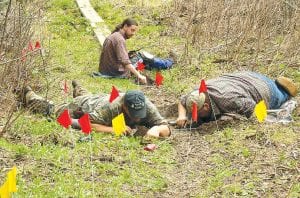In July, the Heart of the Continent Partnership held a meeting in Grand Portage with about 30 stakeholders gathering to discuss the heart of the continent region, described by Steering Committee Chair Doug Franchot as “the lands and communities from Lake Superior to Lake of the Woods and the border lakes region.”
Welcoming attendees to the opening of the July gathering, Franchot spoke to the participants who had not been at previous meetings. “The Heart of the Continent Partnership is an international collaboration of land owners, governmental entities, and others who have come together to learn and work together to sustain and celebrate these communities,” said Franchot.
The HOCP meeting in Grand Portage started with a very interesting evening presentation at the Grand Portage Heritage Center by Doug Birk, a veteran fur trade archeologist. Birk shared very entertaining stories ranging from his childhood interest in archaeology (spurred by artifacts found at a family cabin) to his career researching old maps and logging the portages that crisscross the state of Minnesota. Birk has spent many years studying the trail of the voyageurs on the 8½ mile Grand Portage. “Tracking the voyageurs is the ultimate cold case,” said Birk.
Birk described the meticulous process of surveying and exploring the trail in 10-meter segments, carefully flagging and recording where things were found. “It’s not just what you find,” said Birk, “but where it’s found.”
Finding artifacts was not easy. Thevoyageurs did not own much so they took great care of their few possessions. They lost little along the Grand Portage despite the fact that it was such a rugged route traveling an elevation of 1,300 feet above sea level and frequently flooded by rains and blocked by tumbling rocks and fallen trees. “And we think our roads are bad,” quipped Birk.
However, Birk, with the assistance of Grand Portage National Monument staff, has been able to identify the route, which changed numerous times. The archaeology team has been able to identify where flooding caused a reroute and where oxen and wagons were used. They have identified interesting points along the way, such as the “parting trees”—the last spot where Lake Superior can be seen and 16 poses—
resting places—on the Grand Portage.
Birk said his work is not done yet. “There are still many secrets to learn from the trail,” he said.
Robin Reilly of Quetico Provincial Park said that the story of the voyageurs is something that HOCP can work on to recreate. “To understand any of these places, you have to understand all of them. Historically, ecologically, and culturally, there is no border. It’s a continent-wide picture. There is a lot of activity; a lot of complicated history crammed into this area.”
At the general meeting at the Grand Portage log school the next day, Grand Portage Tribal Chair Norman Deschampe echoed that sentiment, noting that the international border had divided an indigenous nation. He talked about how much Grand Portage had changed since he was young, recalling that there used to be very little traffic on Highway 61. “Thatis why this group is so important, to help preserve the heritage of the communities,” he said.
The general meeting began with introductions of representatives from the various entities in attendance—Tribal Chair Deschampe; Commissioner Jim Johnson; Grand Portage National Monument Superintendent Tim Cochrane; and representatives of the Arrowhead Coalition for Multiple Use, Friends of the Boundary Waters, Sierra Club, Kakabeka Falls Provincial Park; Quetico Foundation; Voyageurs National Park; Superior National Forest and more.
Franchot said he was very pleased by the diverse attendance at the July meeting and he asserted that HOCP is a “neutral” partnership, seeking input from all of the people in the border lakes region. “We as a group have a policy that we don’t take policy positions,” he said. “We just want to work together to help this beautiful region.”
The general meeting included a report by Lisa Radosevich-Craig of the US Forest Service and Paul Danicic of the Friends of the Boundary Waters, who had attended a workshop on Gateway Community Initiatives. Theyare members of the HOCP steering committee and explained that the gateway initiative goals are to help communities that are the “gateways” to public lands develop economic sustainability and connect to those public lands.
Reports were also given on some scientific projects taking place in the HOCP region such as the University of Minnesota Boreal Forest Resilience Project; a water quality monitoring project by Lakehead University in Thunder Bay, the MN Environmental College, and Atikokan High School; the Minnesota Biological Survey; and the moose study underway by the Grand Portage Band and UMD.
The July meeting was right before the North Shore Dragon Boat Festival in Grand Marais, so after a luncheon prepared by the Grand Portage National Monument youth mentors and a lot of informal networking, the HOCP attendees dispersed to gather again in Grand Marais to practice and then race in the dragon boat festival. HOCP won first place in the “Friends & Family” division.
HOCP holds its meetings at a variety of locations and has met in Grand Portage before, in Thunder Bay, Atikokan, St. Paul, and Ely. HOCP meets again this weekend, September 24 – 25, at Voyageurs National Park. For more information, visit www. heartofthecontinent.org.



Loading Comments